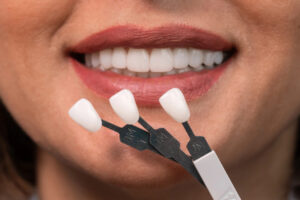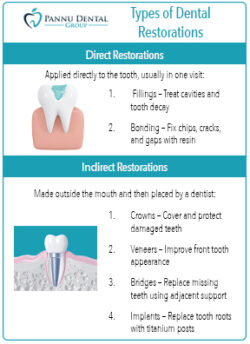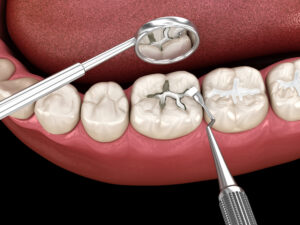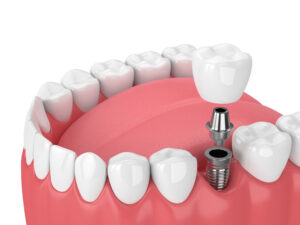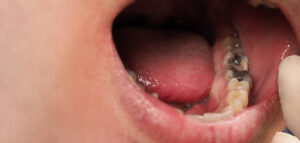
Restorations in dentistry are more than routine procedures. They are personalized solutions that can dramatically enhance your smile, boost your confidence, and protect your long-term oral health.
Whether you are curious about cosmetic dentistry options to brighten a tooth surface or are seeking permanent teeth replacement for multiple missing teeth, broken teeth, and/or chipped teeth, restorative dentistry is the solution.
An experienced dental restorations team with access to the most advanced technologies and techniques in restorative dentistry can provide custom insight into the best dental restorations for your unique oral health needs.
However, before your first consultation with a dental restorations specialist, take a moment to familiarize yourself with the different kinds of dental restorations. Let’s uncover how they can be effectively used to restore function and a beautiful smile.
Table of Contents
What is Restorative Dentistry and How is it Different from Cosmetic Dentistry?
Types of Dental Restorations
Filling vs Restoration – What’s the Difference?
Full Mouth Dental Restoration
Dental Implants
Can Damaged or Rotten Teeth Be Restored?
Enhance Your Smile and Oral Health with Modern Restorations in Dentistry
What is Dental Restoration?
Dental restorations are procedures and treatments that are used in restorative dentistry to repair damaged teeth or replace missing teeth. Additionally, dental restorations can help improve oral health and restore appearance and function.
Dental restorations can include a variety of temporary treatments like partial dentures and removable false teeth. However, they more commonly entail permanent dentition solutions, like dental implants, crowns, veneers, and bridges.
What is Restorative Dentistry and How is it Different from Cosmetic Dentistry?
Restorative dentistry and cosmetic dentistry certainly have some overlaps, but there are some key differences between these dental specialties.
- Restorative dentistry focuses on treatments that replace missing teeth or fix broken teeth to improve function and oral health. These dental restorations improve a patient’s ability to chew and speak. In addition, they also prevent further damage and dental decay by protecting against future dental issues. Common types of dental issues that restorative dentistry can address include cavities, cracked or chipped teeth, and minimal or widespread tooth loss.
- Cosmetic dentistry focuses on restoring and enhancing your teeth and your smile by utilizing aesthetic treatments like teeth whitening, veneers, and tooth reshaping.
Dental restorations focus on treating oral health issues. At the same time, restorative treatment improve appearance by replacing missing or broken teeth. You can improve your smile with permanent artificial teeth, inlays and onlays, and other common solutions.
An example is dental implants or CEREC crowns, which are both common treatments in dental restorations, and which often serve both purposes. Dental implants and crowns are made of composite materials designed to look like natural teeth. In addition, dental implants can retain their tooth-colored appearance for years.
As a result, your dentist will address your missing teeth or other issues like tooth decay and cavities. They will also restore a permanent, natural-looking enamel appearance.
Types of Dental Restorations
There are many different dental restoration treatments, and the best course of action for your oral health needs will be determined after an in-depth conversation with your dentist.
Dental restoration treatments can be filtered into two categories:
- Direct Restorations: Direct dental restorations are treatments that are applied directly into the mouth, such as fillings and bonding.
- Indirect Restorations: Indirect restorations are custom-made solutions that are crafted outside the mouth with advanced technological tools and then applied or inserted to address damaged or missing teeth. Examples of indirect restorations include crowns, veneers, bridges, and dental implants.
Most Common Types of Dental Restorations – Indirect and Direct
Fillings
Dentists commonly treat cavities caused by tooth decay with fillings. In addition, fillings are made of a variety of different composite materials, including composite resin, dental amalgam, and glass ionomer. Composite resins are typically tooth-colored and often used for visible areas of the teeth.
Inlays and Onlays
In restorative dentistry, inlays and onlays are used to fill cavities and are then cemented in place in the tooth. Inlays and onlays are an alternative treatment to a direct restoration, and they are made from composite, amalgam, or glass ionomer.
Dental Crowns
Dental crowns are dental restorations that cover the entire visible portion of a tooth. It provides both a supportive and natural tooth structure, and restores the tooth’s shape and function. Crowns can be made of various composite materials, including porcelain, metal, or a combination of both.
Dental Bridge
Bridges aim to replace teeth by anchoring to your natural teeth on either side of the gap where an entire tooth is missing. Bridges are a combination treatment, as they are often comprised of dental crowns that are connected.
Dental Implants
Dental implants are a life-long solution that entails placing a titanium post into the jawbone to serve as a natural tooth root. From there, a replacement tooth or bridge can be placed on top, instantly creating a healthier smile. Dental implants can replace multiple missing teeth and can help prevent future dental health issues. For instance, like further damage to the tooth structure or tooth enamel.
Veneers
Dentists place a thin layer of material over the tooth to create a veneer. This layer mimics the look and feel of natural enamel. Dentists often recommend veneers when tooth enamel is discolored or damaged. Veneers also protect the tooth’s surface from further harm.
Dentures
Dentures are removable dental devices that replace multiple missing teeth. In addition, dentures can be classified as full dentures, which replace all teeth in an arch, or partial dentures, which replace some missing teeth or even a single missing tooth.
Filling vs Restoration – What’s the Difference?
Fillings can be classified as a type of dental restoration, but dental restorations certainly include more than fillings alone.
Dentists use fillings to treat minor cavities caused by tooth decay and apply them directly in the mouth. Filling material can vary and can include composite resins, acrylic resin, silver amalgam, and other dental materials.
Restorations, however, can be direct restorations like fillings or indirect restorations like crowns, bridges, implants, and more. In essence, fillings are used for minor repairs to a tooth and are applied in a single trip to the dentist. Dentist use restorations to treat complex oral health issues and may schedule one or multiple office visits.
When it comes to lifespan, it should be noted that dental fillings are generally less durable than other indirect restorations like crowns and implants. This is especially true for cases of significant tooth damage or tooth loss.
Full Mouth Dental Restoration – What Does it Involve?
If you have multiple missing teeth and require major tooth restorations, then your dentist may recommend a full mouth dental restoration, also referred to as a full mouth rehabilitation or reconstruction.
While this sounds like an intimidating treatment, these tooth restorations are common and are conducted with care and expertise.
Diagnosis and game plan for tooth restorations
The first step to full mouth restorations is creating a plan. Your dentist and oral health team will conduct a thorough examination and recommend a treatment that addresses all of your cosmetic and oral health issues.
Types of Full Mouth Dental Restorations
After this initial exam, your dentist may recommend one or more of the following restorations.
- Dental Implants: Full mouth dental implants replace entire rows of missing teeth with artificial tooth roots in the form of titanium alloy posts, which are topped with natural looking dental crowns.
- Crowns: Dental crowns may be used to cap damaged or decayed teeth with strong and protective material.
- Bridges: Bridges replace missing teeth with artificial teeth or multiple artificial teeth. Bridges are placed over the gap created by a missing tooth, supported by adjacent teeth or implants.
- Veneers: Used often in cosmetic dental restorations, veneers are tooth-colored shells that are placed on the front of a tooth or multiple teeth to improve appearance.
- Dentures: Dentures can be removable or fixed replacement teeth, and they are a common type of treatment for complete tooth loss.
- Gum Disease Treatment: Often, you may need an initial treatment for other oral health issues that lead to a missing tooth or teeth. Addressing periodontal issues is the first step before any permanent dental restorations can be conducted.
- Bone or Soft Tissue Grafts: Bone and soft tissue grafts are another common treatment that may be required before full mouth restorations. Grafts are used to enhance the support for implants or other restorations, creating a permanent solution for oral health issues.
Dental Implants – The Gold Standard in Tooth Restoration
When it comes to dental restorations that are comfortable, comprehensive, and long-lasting, dental implants are the gold standard.
Dental implants can be used to replace an entire row of missing teeth or just a lone missing tooth. A titanium post anchors a natural-looking crown to the jawbone.
There are different types of dental implants, too, in modern restorative dentistry practices.
For example, all-on-four dental implants can replace entire rows of teeth with just four implants. A single dental implant is an option for patients who are missing a single tooth, and who do not have severe damage to other teeth.
Check out our patient testimonial from someone who chose dental implants over dentures and achieved a full mouth restoration.
Benefits of Dental Implants
- Long-lasting – When it comes to dental restorations, implants are the longest-lasting solution, as dental implants can last for 20 years or more.
- Comfortable – Dental implants look and perform just like natural teeth and will instantly improve your ability to chew and speak, as well as improve your natural appearance.
- Minimal maintenance – Dental implants require the same good oral hygiene habits as your natural teeth, like brushing and flossing and having regular check-ups at the dentist’s office. As a result, you will not need extra care or special comfort after the dental implant procedure.
- Helps restore oral health – By serving as strong artificial tooth roots, dental implants can alleviate dental issues, like bone loss or further tooth decay in your remaining teeth.
Can Damaged or Rotten Teeth Be Restored?
Dental restoration treatments offer permanent solutions and replacements for missing teeth. In some instances, damaged teeth can be fixed instead of wholly removed.
For example, root canals are often used to remedy dead teeth and stop them from decaying further. Then, crowns or veneers may be used to restore a tooth’s natural-looking appearance.
However, there are limitations to these restorative treatments. If a tooth causes bone loss, decay, or worsens other issues like gum disease, the dentist may recommend extraction as the only option.
Do not be concerned if your dentist recommends an extraction followed by a thorough dental restoration treatment. With permanent solutions like dental implants, you will feel more confident and healthier after the extraction and restorative treatment are complete.
Enhance Your Smile and Oral Health with Modern Restorations in Dentistry
Pannu Dental Group offers cosmetic treatments like tooth whitening, veneers, and dental implants. Our expert team also know how to treat severely damaged or missing teeth with expert care.
We offer a range of the most modern treatments and technologies in restorative dentistry. Our professional dental team has decades of experience addressing both simple and complex dental issues of all kinds.
Therefore, our caring team will start with a consultation where we will conduct a thorough exam and then explore and explain all your many options when it comes to dental restorations. Our constant focus is on our clients’ comfort and exceptional results.
Therefore, we will work together to create a treatment plan that is cost effective, and which ensures your oral health and confidence for years and decades to come.
Restorations in Dentistry that Truly enhance your smile and well-being
Don’t wait to schedule your initial appointment. When it comes to dental restorations, timeliness is key. The sooner you reach out to Pannu Dental Group, the sooner you’ll walk out of our dentist’s office with a brilliant new smile.
We are always available to answer your questions and explain your options.
Connect with us today and discover a path to exceptional oral health that will improve your life in every way, and from the inside out.
Schedule your consultation today!
Dr. Dalvir S. Pannu has been a practicing dentist since 1995. In 1996 he opened his first dental practice in India, where he gained invaluable experience and acumen. In October of 1997 he was invited by the American Dental Association (ADA) to present the table clinic on Endodontics, at their annual session held in Washington, D.C. At this time he fell in love with the United States and became passionate about practicing dentistry in California. He became particularly enamored of the San Francisco Bay area, and soon took up residence and work here.
